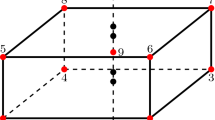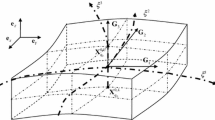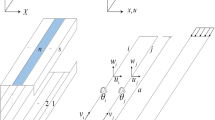Abstract
In this paper, the recently-developed solid-shell element SHB8PS is used for the analysis of a representative set of popular limit-point buckling benchmark problems. For this purpose, the element has been implemented in Abaqus/Standard finite element software and the modified Riks method was employed as an efficient path-following strategy. For the benchmark problems tested, the new element shows better performance compared to solid elements and often performs as well as state-of-the-art shell elements. In contrast to shell elements, it allows for the accurate prescription of boundary conditions as applied to the actual edges of the structure.
Similar content being viewed by others
References
E. Domissy, Formulation et évaluation d’éléments finis volumiques modifiés pour l’analyse linéaire et non linéaire des coques, PhD thesis, UT Compiègne, France (1997).
C. Cho, H. C. Park and S. W. Lee, Stability analysis using a geometrically nonlinear assumed strain solid shell element model, Finite Elements Anal Des, 29 (1998) 121–135.
R. Hauptmann and K. Schweizerhof, A systematic development of solid-shell element formulations for linear and nonlinear analyses employing only displacement degrees of freedom, Int. J. Numer. Methods Eng., 42 (1998) 49–69.
D. Lemosse, Eléments finis isoparamétriques tridimensionnels pour l’étude des structures minces, PhD thesis, INSA-Rouen, France (2000).
K. Y. Sze and L. Q., Yao, A hybrid stress ANS solid-shell element and its generalization for smart structure modelling. Part I-solid-shell element formulation, Int. J. Numer. Methods Eng., 48 (2000) 545–564.
R. Hauptmann, S. Doll, M. Harnau and K. Schweizerhof, Solid-shell elements with linear and quadratic shape functions at large deformations with nearly incompressible materials, Comput. Struct., 79 (2001) 1671–1685.
F. Abed-Meraim, A. Combescure, SHB8PS a new intelligent assumed strain continuum mechanics shell element for impact analysis on a rotating body, First MIT conference on computational fluid and solid mechanics, Cambridge, USA, 2001.
F. Abed-Meraim, A. Combescure, SHB8PS — a new adaptive, assumed-strain continuum mechanics shell element for impact analysis, Comput. Struct., 80 (2002) 791–803.
A. Legay, A. Combescure, Elastoplastic stability analysis of shells using the physically stabilized finite element SHB8PS, Int. J. Numer. Methods Eng., 57 (2003) 1299–1322.
J. C. Simo and M. S. Rifai, A class of mixed assumed strain methods and the method of incompatible modes, Int. J. Numer. Methods Eng., 29 (1990) 1595–1638.
J. C. Simo and F. Armero, Geometrically non-linear enhanced strain mixed methods and the method of incompatible modes, Int. J. Numer. Methods Eng., 33 (1992) 1413–1449.
J. C. Simo, F. Armero and R. L. Taylor, Improved versions of assumed enhanced strain tri- linear elements for 3D finite deformation problems, Comput. Methods Appl. Mech. Eng., 110 (1993) 359–386.
L. Vu-Quoc and X. G. Tan, Optimal solid shells for nonlinear analyses of multilayer composites, I. Statics, Comput. Methods Appl. Mech. Eng., 192 (2003) 975–1016.
Y. I. Chen and G. Y. Wu, A mixed 8-node hexahedral element based on the Hu-Washizu principle and the field extrapolation technique, Struct. Eng. Mech., 17 (2004) 113–140.
K. D. Kim, G. Z. Liu and S. C. Han, A resultant 8-node solid-shell element for geometrically nonlinear analysis, Comput. Mech., 35 (2005) 315–331.
R. J. Alves de Sousa, R. P. R. Cardoso, R. A. Fontes Valente, J. W. Yoon, J. J. Gracio and R. M. Natal Jorge, A new one-point quadrature enhanced assumed strain (EAS) solid-shell element with multiple integration points along thickness: Part I — Geometrically linear applications, Int. J. Numer. Methods Eng., 62 (2005) 952–977.
R. J. Alves de Sousa, R. P. R. Cardoso, R. A. Fontes Valente, J. W. Yoon, J. J. Gracio and R. M. Natal Jorge, A new one-point quadrature enhanced assumed strain (EAS) solid-shell element with multiple integration points along thickness: Part II — Nonlinear applications, Int. J. Numer. Methods Eng., 67 (2006) 160–188.
S. Reese, A large deformation solid-shell concept based on reduced integration with hourglass stabilization, Int. J. Numer. Methods Eng., 69 (2007) 1671–1716.
F. Abed-Meraim, A. Combescure, An improved assumed strain solid-shell element formulation with physical stabilization for geometric nonlinear applications and elastic-plastic stability analysis, Int. J. Numer. Methods Eng., 80 (2009) 1640–1686.
T. Belytschko and L. P. Bindeman, Assumed strain stabilization of the eight node hexahedral element, Comput. Methods Appl. Mech. Eng., 105 (1993) 225–260.
J. C. Simo and T. J. R. Hughes, On the variational foundations of assumed strain methods, J. Appl. Mech., 53 (1986) 51–54.
D. P. Flanagan and T. Belytschko, A uniform strain hexahedron and quadrilateral with orthogonal hourglass control, Int. J. Numer. Methods Eng., 17 (1981) 679–706.
S. P. Timoshenko and J. M. Gere, Theory of elastic stability, New York: McGraw-Hill (1961).
W. T. Koiter, On the stability of elastic equilibrium, PhD thesis, Delft (1945), Trans. NASA Tech. Trans. F10 (1967).
J. W. Hutchinson and W. T. Koiter, Post-buckling theory, Appl. Mech. Rev., 23 (1970) 1353–1366.
J. M. T. Thompson and G. W. Hunt, A General theory of elastic Stability, New York: Wiley (1973).
B. Budiansky, Theory of buckling and post-buckling behaviour of elastic structures, Adv. Appl. Mech. 14 (1974) 1–65.
ABAQUS Version 6.7 Documentation, Dassault Systèmes Simulia Corp. (2007).
E. Riks, An incremental approach to the solution of snapping and buckling problems, Int. J. Solids Struct., 15 (1979) 529–551.
M. A. Crisfield, A fast incremental/iterative solution procedure that handles “snap-through”, Comput. Struct., 13 (1981) 55–62.
E. Ramm, Strategies for tracing the nonlinear response near limit points. In: W. Wunderlich, E. Stein, K. J. Bathe, editors, Nonlinear finite element analysis in structural mechanics, New York: Springer-Verlag (1981) 63–89.
I. Leahu-Aluas and F. Abed-Meraim, A proposed set of popular limit point buckling benchmark problems, Struct. Eng. Mech. 38 (2011).
P. Wriggers and J. C. Simo, A general procedure for the direct computation of turning and bifurcation points, Int. J. Numer. Methods Eng., 30 (1990) 155–176.
L. Jiang and M. W. Chernuka, A corotational formulation for geometrically nonlinear finite element analysis of spatial beams, Trans. Canadian Soc. Mech. Eng., 18 (1994) 65–88.
E. H. Boutyour, H. Zahrouni, M. Potier-Ferry and M. Boudi, Bifurcation points and bifurcated branches by an asymptotic numerical method and Padé approximants, Int. J. Numer. Methods Eng., 60 (2004) 1987–2012.
K. S. Surana, Geometrically nonlinear formulation for curved shell elements, Int. J. Numer. Methods Eng., 19 (1983) 581–615.
J. C. Simo and L. Vu-Quoc, A three-dimensional finitestrain rod model. Part II: Computational aspects, Comput. Methods Appl. Mech. Eng., 58 (1986) 79–116.
D. A. DaDeppo and R. Schmidt, Instability of clampedhinged circular arches subjected to a point load. Trans ASME J Appl Mech 42 (1975) 894–896.
J. K. Kim and Y. H. Kim, A predictor-corrector method for structural nonlinear analysis, Comput. Methods Appl. Mech. Eng., 191 (2001) 959–974.
S. Klinkel and W. Wagner, A geometrical non-linear brick element based on the EAS-method, Int. J. Numer. Methods Eng., 40 (1997) 4529–4545.
K. Y. Sze and S. J. Zheng, A stabilized hybrid-stress solid element for geometrically nonlinear homogeneous and laminated shell analyses, Comput. Methods Appl. Mech. Eng., 191 (2002) 1945–1966.
K. Y. Sze, X. H. Liu and S. H. Lo, Popular benchmark problems for geometric nonlinear analysis of shells, Finite Elements Anal. Des., 40 (2004) 1551–1569.
Author information
Authors and Affiliations
Corresponding author
Additional information
This paper was recommended for publication in revised form by Editor Maenghyo Cho
Farid Abed-Meraim received his Ph.D. in Theoretical and Applied Mechanics from École Polytechnique, Paris in 1999. He joined Arts et Métiers ParisTech, Metz Campus in 2000, where he is currently an associate professor at the LEM3 laboratory. His main research interests include structural stability (bifurcation) analysis of dissipative systems (elasto-plastic, visco-elastic and visco-plastic), material instability modeling in relation to the prediction of formability of metal sheets, as well as finite element technology (solid-shell formulations).
Marc Killpack received his B.S. and his M.S. in Mechanical Engineering from Brigham Young University and Georgia Institute of Technology, USA, respectively, in 2007 and 2008. After a joint program with Arts et Métiers Paris-Tech Metz, he joined Georgia Institute of Technology, where he is pursuing a robotics Ph.D. degree. His research interests cover issues related to controls, dynamics, and computer vision (perception).
Rights and permissions
About this article
Cite this article
Killpack, M., Abed-Meraim, F. Limit-point buckling analyses using solid, shell and solid-shell elements. J Mech Sci Technol 25, 1105–1117 (2011). https://doi.org/10.1007/s12206-011-0305-3
Received:
Revised:
Accepted:
Published:
Issue Date:
DOI: https://doi.org/10.1007/s12206-011-0305-3




